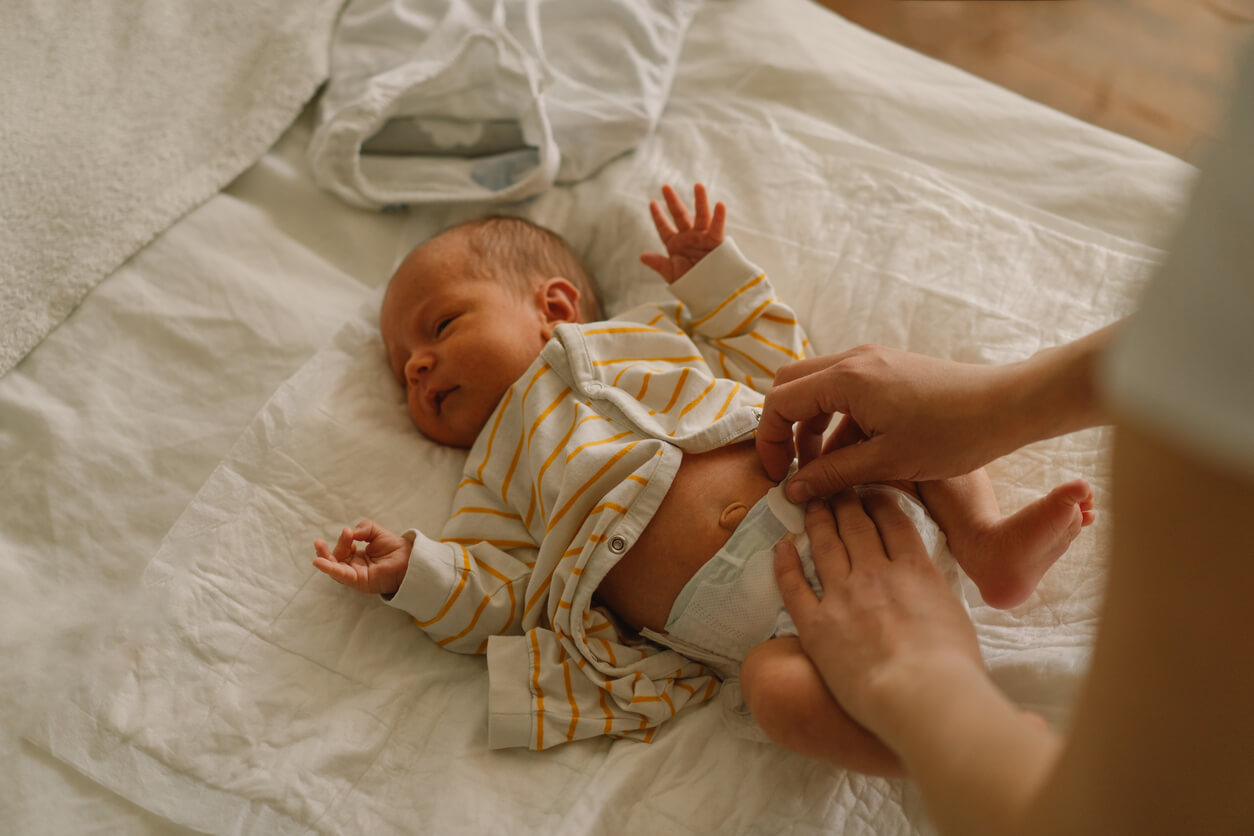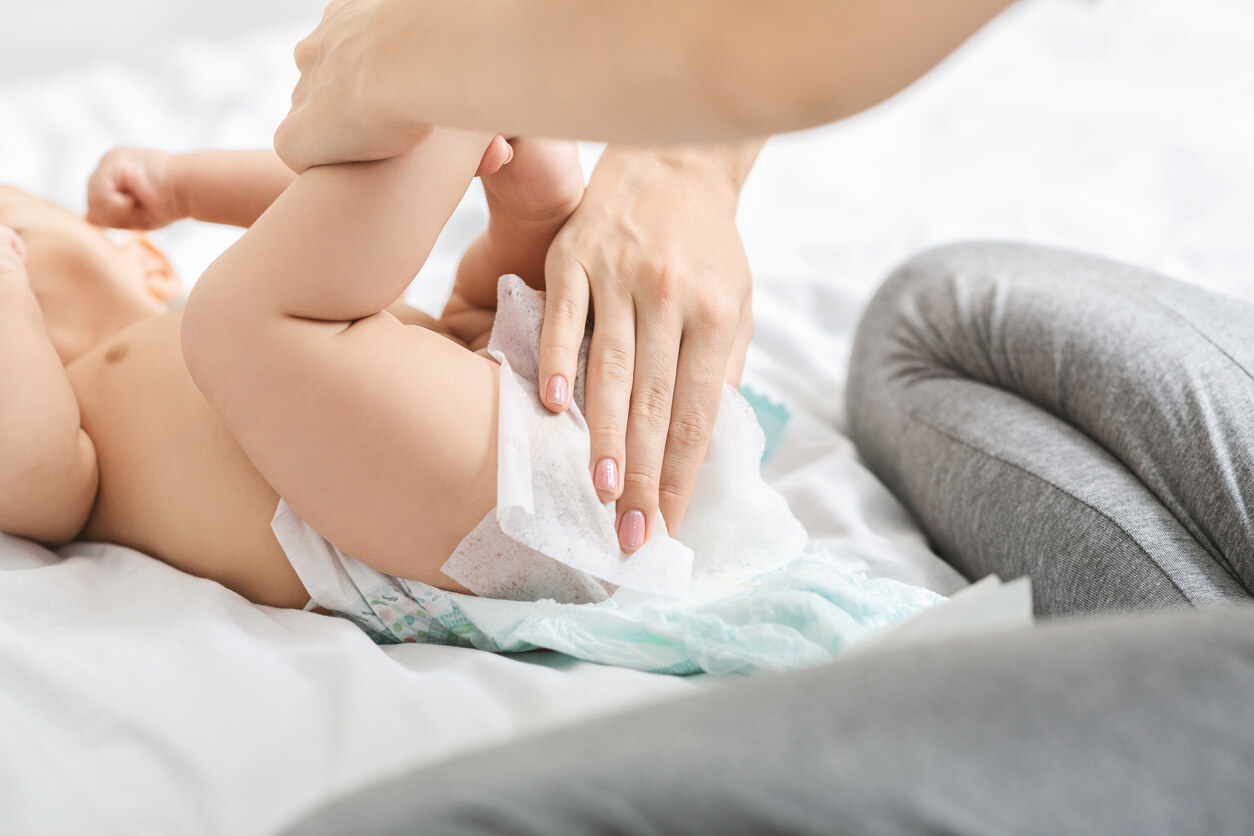Genital Care in Infants


Written and verified by the dermatologist Maria del Carmen Hernandez
It’s very important to take care of the genitals of babies. This is simple and, not only does it contribute to the prevention of infections, but also keeps them healthy. The measures will differ if it’s a boy or a girl, but the skin is just as sensitive and delicate in both cases. Keep reading to discover more about genital care in infants.
The time to change their diaper
Diaper changes in babies should be done frequently, and cleaning should begin above the genitals. In fact, hygiene should always be from the front to the back, so as not to transfer germs to the urethra or vagina. The last area to clean during a diaper change is the anus and perineum. Afterward, the entire diaper area should be dried thoroughly without generating friction and a hypoallergenic protective balm should be applied.
According to studies published by Pediatric Dermatology, the permanence of moisture in the area can trigger diaper rash. It’s best to change it regularly to prevent the combination of fecal matter and urine from causing a rash in the area.
You may be interested in: Learn How to Properly Change a Diaper, Step by Step
Genital care and hygiene in babies
For the hygiene of the baby’s genitals, it’s best to use warm water and cotton swabs. If needed, a small amount of mild, hypoallergenic, alcohol-free soap can be added to the water. Remember that diaper creams, sweat, and other substances can accumulate and deposit in the inguinal folds. Therefore, the time to clean may be when changing the diaper or at bath time.

Genital care in girls
In girls, debris from hygiene products or fecal matter often accumulates in and around the labia. These areas should be sanitized only with warm water and absorbent cotton. In addition, it should always be done from front to back, to avoid vulvovaginitis, vulvitis, or urinary tract infection.
The use of deodorants or vaginal soaps isn’t recommended, as they can increase the risk of infection by altering the natural chemical balance and pH of the vagina of newborn girls. At the same time, it’s not uncommon for girls to have a thick, milky discharge called physiological leukorrhea, which doesn’t require hygiene. However, it’ll disappear as the maternal hormones cease to have an effect on the baby’s body.
Genital care in boys
The penis and scrotum should be rinsed gently with warm water and absorbent cotton. Then, drying should be done without friction, but rather with gentle dabbing with a soft towel. Only the external part of the foreskin needs to be rinsed, so it’s not necessary to retract it. In fact, it usually retracts easily when the child is between 2 and 3 years old.
In general, a milky white substance, called smegma, is usually present under the foreskin. This isn’t a cause for concern, as it’s generated by the accumulation of natural secretions and dead skin cells.
Products to avoid in genital care for babies
Genital care for newborn babies requires certain products. In fact, these should be dye-free, fragrance-free, and alcohol-free.
Talc or cornstarch
It’s not advisable to use talcum powder on any part of the baby’s body, including the intimate areas. This is because it has tiny particles that can be inhaled quite easily by the baby. In addition, it creates a film on the skin that can prevent the sweat glands from functioning and eliminating sweat properly.

Wet wipes
There’s a lot of controversy surrounding the use of wet wipes for baby hygiene. This is because it’s associated with the generation of synechiae in the vulvar area. In girls, these products don’t clean as effectively as water.
Chemicals
Product labels should be read carefully, as those containing fragrances, dyes, parabens, or phthalates are discouraged. This is due to their high likelihood of causing skin irritation in infants. Even some products with botanical or herbal ingredients can cause allergic skin reactions.
Read also: Baby’s skin during the first bath
Proper hygiene is essential
Genital hygiene and care in babies require some special measures and advice because of the delicacy of the area. If they’re not properly cared for, this can result in infections that can cause serious complications.
It’s very important to take care of the genitals of babies. This is simple and, not only does it contribute to the prevention of infections, but also keeps them healthy. The measures will differ if it’s a boy or a girl, but the skin is just as sensitive and delicate in both cases. Keep reading to discover more about genital care in infants.
The time to change their diaper
Diaper changes in babies should be done frequently, and cleaning should begin above the genitals. In fact, hygiene should always be from the front to the back, so as not to transfer germs to the urethra or vagina. The last area to clean during a diaper change is the anus and perineum. Afterward, the entire diaper area should be dried thoroughly without generating friction and a hypoallergenic protective balm should be applied.
According to studies published by Pediatric Dermatology, the permanence of moisture in the area can trigger diaper rash. It’s best to change it regularly to prevent the combination of fecal matter and urine from causing a rash in the area.
You may be interested in: Learn How to Properly Change a Diaper, Step by Step
Genital care and hygiene in babies
For the hygiene of the baby’s genitals, it’s best to use warm water and cotton swabs. If needed, a small amount of mild, hypoallergenic, alcohol-free soap can be added to the water. Remember that diaper creams, sweat, and other substances can accumulate and deposit in the inguinal folds. Therefore, the time to clean may be when changing the diaper or at bath time.

Genital care in girls
In girls, debris from hygiene products or fecal matter often accumulates in and around the labia. These areas should be sanitized only with warm water and absorbent cotton. In addition, it should always be done from front to back, to avoid vulvovaginitis, vulvitis, or urinary tract infection.
The use of deodorants or vaginal soaps isn’t recommended, as they can increase the risk of infection by altering the natural chemical balance and pH of the vagina of newborn girls. At the same time, it’s not uncommon for girls to have a thick, milky discharge called physiological leukorrhea, which doesn’t require hygiene. However, it’ll disappear as the maternal hormones cease to have an effect on the baby’s body.
Genital care in boys
The penis and scrotum should be rinsed gently with warm water and absorbent cotton. Then, drying should be done without friction, but rather with gentle dabbing with a soft towel. Only the external part of the foreskin needs to be rinsed, so it’s not necessary to retract it. In fact, it usually retracts easily when the child is between 2 and 3 years old.
In general, a milky white substance, called smegma, is usually present under the foreskin. This isn’t a cause for concern, as it’s generated by the accumulation of natural secretions and dead skin cells.
Products to avoid in genital care for babies
Genital care for newborn babies requires certain products. In fact, these should be dye-free, fragrance-free, and alcohol-free.
Talc or cornstarch
It’s not advisable to use talcum powder on any part of the baby’s body, including the intimate areas. This is because it has tiny particles that can be inhaled quite easily by the baby. In addition, it creates a film on the skin that can prevent the sweat glands from functioning and eliminating sweat properly.

Wet wipes
There’s a lot of controversy surrounding the use of wet wipes for baby hygiene. This is because it’s associated with the generation of synechiae in the vulvar area. In girls, these products don’t clean as effectively as water.
Chemicals
Product labels should be read carefully, as those containing fragrances, dyes, parabens, or phthalates are discouraged. This is due to their high likelihood of causing skin irritation in infants. Even some products with botanical or herbal ingredients can cause allergic skin reactions.
Read also: Baby’s skin during the first bath
Proper hygiene is essential
Genital hygiene and care in babies require some special measures and advice because of the delicacy of the area. If they’re not properly cared for, this can result in infections that can cause serious complications.
All cited sources were thoroughly reviewed by our team to ensure their quality, reliability, currency, and validity. The bibliography of this article was considered reliable and of academic or scientific accuracy.
- Blume-Peytavi U, Kanti V. Prevention and treatment of diaper dermatitis. Pediatr Dermatol. 2018 Mar;35 Suppl 1:s19-s23. doi: 10.1111/pde.13495. PMID: 29596731.
- Phang KN, Maznin NL, Yip WK. Hand hygiene in the nursery during diaper changing. Int J Evid Based Healthc. 2012 Dec;10(4):382-7. doi: 10.1111/j.1744-1609.2012.00297.x. PMID: 23173663.
- Wesner, E., Vassantachart, JM y Jacob, SE (2019). Arte de la prevención: La importancia de las prácticas adecuadas de cambio de pañales. Revista internacional de dermatología femenina , 5 (4), 233–234. https://doi.org/10.1016/j.ijwd.2019.02.005
This text is provided for informational purposes only and does not replace consultation with a professional. If in doubt, consult your specialist.








